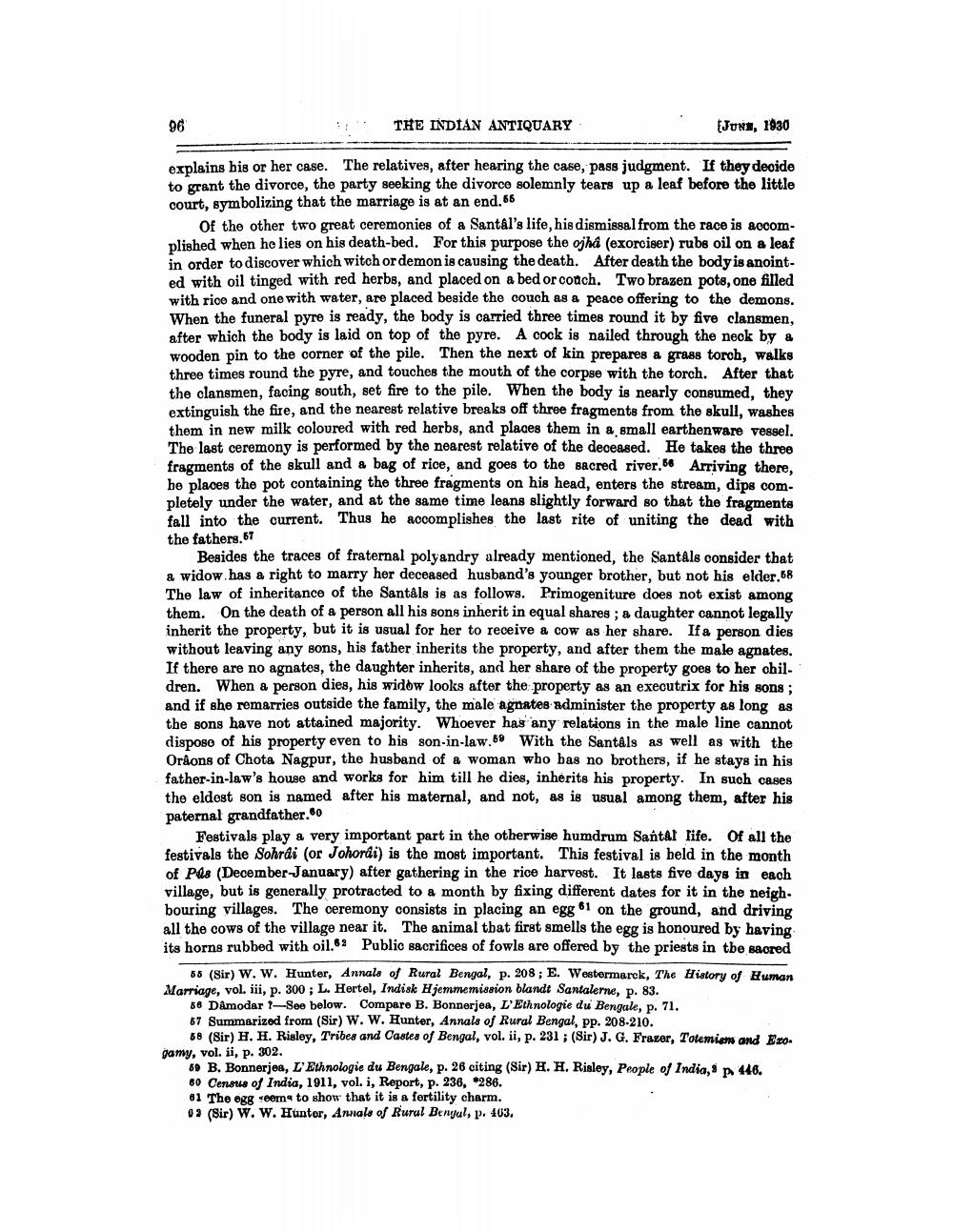________________
THE INDIAN ANTIQUARY
(JUNE, 1930
explains his or her case. The relatives, after hearing the case, pass judgment. If they decide to grant the divorce, the party seeking the divorce solemnly tears up a leaf before the little court, symbolizing that the marriage is at an end. 65
96
Of the other two great ceremonies of a Santâl's life, his dismissal from the race is accomplished when he lies on his death-bed. For this purpose the ojha (exorciser) rubs oil on a leaf in order to discover which witch or demon is causing the death. After death the body is anointed with oil tinged with red herbs, and placed on a bed or couch. Two brazen pots, one filled with rice and one with water, are placed beside the couch as a peace offering to the demons. When the funeral pyre is ready, the body is carried three times round it by five clansmen, after which the body is laid on top of the pyre. A cock is nailed through the neck by a wooden pin to the corner of the pile. Then the next of kin prepares a grass torch, walks three times round the pyre, and touches the mouth of the corpse with the torch. After that the clansmen, facing south, set fire to the pile. When the body is nearly consumed, they extinguish the fire, and the nearest relative breaks off three fragments from the skull, washes them in new milk coloured with red herbs, and places them in a small earthenware vessel. The last ceremony is performed by the nearest relative of the deceased. He takes the three fragments of the skull and a bag of rice, and goes to the sacred river. 56 Arriving there, he places the pot containing the three fragments on his head, enters the stream, dips completely under the water, and at the same time leans slightly forward so that the fragments fall into the current. Thus he accomplishes the last rite of uniting the dead with the fathers.67
Besides the traces of fraternal polyandry already mentioned, the Santåls consider that a widow has a right to marry her deceased husband's younger brother, but not his elder.58 The law of inheritance of the Santâls is as follows. Primogeniture does not exist among them. On the death of a person all his sons inherit in equal shares; a daughter cannot legally inherit the property, but it is usual for her to receive a cow as her share. If a person dies without leaving any sons, his father inherits the property, and after them the male agnates. If there are no agnates, the daughter inherits, and her share of the property goes to her children. When a person dies, his widow looks after the property as an executrix for his sons; and if she remarries outside the family, the male agnates administer the property as long as the sons have not attained majority. Whoever has any relations in the male line cannot dispose of his property even to his son-in-law.69 With the Santâls as well as with the Orâons of Chota Nagpur, the husband of a woman who has no brothers, if he stays in his father-in-law's house and works for him till he dies, inherits his property. In such cases the eldest son is named after his maternal, and not, as is usual among them, after his paternal grandfather.60
Festivals play a very important part in the otherwise humdrum Santal life. Of all the festivals the Sohrdi (or Johordi) is the most important. This festival is held in the month of Pas (December-January) after gathering in the rice harvest. It lasts five days in each village, but is generally protracted to a month by fixing different dates for it in the neigh. bouring villages. The ceremony consists in placing an egg 61 on the ground, and driving all the cows of the village near it. The animal that first smells the egg is honoured by having its horns rubbed with oil.62 Public sacrifices of fowls are offered by the priests in the sacred
55 (Sir) W. W. Hunter, Annals of Rural Bengal, p. 208; E. Westermarck, The History of Human Marriage, vol. iii, p. 300; L. Hertel, Indisk Hjemmemission blandt Santalerne, p. 83.
56 Dâmodar ?-See below. Compare B. Bonnerjea, L'Ethnologie du Bengale, p. 71.
57 Summarized from (Sir) W. W. Hunter, Annals of Rural Bengal, pp. 208-210.
58 (Sir) H. H. Risley, Tribes and Castes of Bengal, vol. ii, p. 231; (Sir) J. G. Frazer, Totemiem and Ero. gamy, vol. ii, p. 302.
59 B. Bonnerjea, L'Ethnologie du Bengale, p. 26 citing (Sir) H. H. Risley, People of India, p. 446.
60 Census of India, 1911, vol. i, Report, p. 236, *286. 61 The egg seems to show that it is a fertility charm.
03 (Sir) W. W. Hunter, Annals of Rural Bengal, p. 463.




